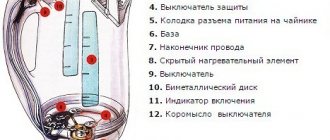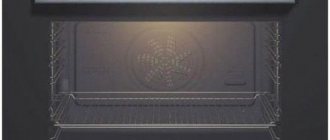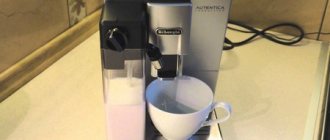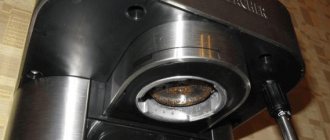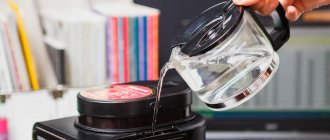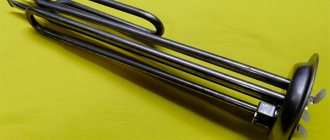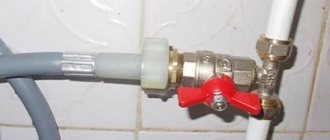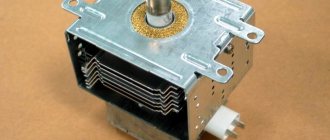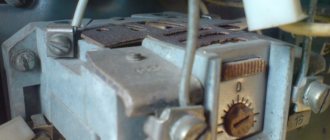Automatic coffee machines are very convenient to use: the drink is prepared in a matter of minutes, and you only need to put in a minimum of effort. Therefore, it becomes especially disappointing when a useful assistant in the kitchen breaks down. Repairing a coffee machine in service centers is a long and expensive undertaking. But sometimes the problem can be solved on your own, without resorting to the help of specialists. Let's look at the most common coffee machine malfunctions and how to fix them at home.
Why does a coffee machine break down?
Proper operation and care of the coffee machine ensures long-term service and stable operation. Unfortunately, in an office environment, coffee machines often work continuously, almost to the point of wear and tear, and it is not always possible to take good care of and thoroughly clean all the elements of its design: there is simply not enough time. However, regular maintenance, cleaning and general checks on the functionality of the coffee machine will significantly reduce the risk of breakdown. Here are the points you should pay attention to in advance.
- Low quality water is used to make coffee. If you use ordinary tap water, unfiltered, saturated with chlorine and other harmful impurities, sooner or later this will lead to the formation of scale and limescale on the internal parts of the coffee machine.
- Power outages. Periodic power failures and frequent switching on/off of the device also contribute to breakdowns.
- Wear of parts during long-term use. If the coffee machine has been serving you faithfully for more than a year, natural wear and tear of the structure may occur. Here it is better to consult a specialist: perhaps some parts still need to be replaced.
- Careless operation of the device, lack of regular cleaning. Cleaning your coffee machine is one of the most important maintenance components. Often, special cleaning products, descaling tablets, etc. are included with the device, but in certain cases, thorough manual cleaning is also necessary.
- Ingress of foreign objects into the structure, clogged filters.
These are just general reasons why your favorite coffee machine may suddenly break down. Next, we will highlight typical types of breakdowns that can occur with coffee appliances of various types and functionality.
Lost pressure in the coffee machine - main symptoms
In order to check the pressure in the car, you need to focus on the pump. Signs that there is a problem are:
- weak supply pressure for coffee drink;
- complete absence of coffee flow.
Unfortunately, this problem often occurs in capsule coffee machines that are out of warranty. The presence of a malfunction is easy to notice: just start making coffee and observe the intensity of its supply.
Another sign that there is no pressure in the coffee machine is a significant deterioration in the quality of the coffee and a complete absence of foam. Coffee deteriorates in the case of low pressure, when its value drops below 9 bar.
Why doesn't the coffee machine turn on?
If your coffee maker won't turn on, it could be due to many problems. Among them, the most common ones are most often identified.
- Electrical cable is bent or broken. To eliminate the defect, it must be replaced.
- When there are sudden power surges in the network, the fuse trips and the coffee machine stops turning on. In order for it to work again, this part must be replaced. It is recommended to use a stabilizer that will prevent damage to household appliances.
- If the coffee maker is running continuously, it may overheat. In this case, the thermal protection will work and turn off the device. In this situation, you just need to let the coffee machine cool down.
- With prolonged use, scale forms in the coffee maker and coffee deposits appear. All this can lead to open contacts. To start brewing coffee again, you need to thoroughly clean the device and restore the contacts.
- Control module failure. This defect is the most serious, and to correct it you will have to seek the help of professionals.
However, the problem is not necessarily with the coffee maker. First you need to check the following.
- Make sure there is electricity in the apartment. It is quite possible that the plugs in the electrical panel were knocked out.
- The machine may turn off due to clogged filters. They need to be cleaned or replaced. After this, the device will operate normally.
The coffee machine does not respond to button presses
In such a situation, you should immediately check whether there is water in the tank and coffee in the container. In addition, you need to make sure that the knobs and buttons are in the correct position. Sometimes a protection may be triggered that will not turn off until everything returns to its original position. If this does not work, it is recommended that you carefully study the instructions. It can help determine the cause of the breakdown. Most often, it can be indicated on the device display.
Sometimes, to eliminate a defect, you will need to remove the control panel and check the contacts with a tester. Perhaps the cause of the malfunction is that the buttons are dirty, causing them to stick and not work. In this case, you must thoroughly clean the control panel contacts and buttons.
If this does not help, then most likely the cause of the malfunction is an electronic failure. In this case, you should not try to repair the coffee maker yourself. You must immediately take it to a service center.
Extraneous noise + complete lack of work
If your coffee machine is noisy and does not brew coffee, then you need to independently find the cause of the breakdown. First of all, determine whether the water is heated and supplied in a heated state. If the coffee machine takes water and heats it, but does not dispense coffee, most likely the cause of the breakdown is the formation of an air lock. In this case, the repair boils down to running hot water through the cappuccino maker, which should fix the problem. If coffee flows from the spout in a weak stream, try rinsing the entire system with a special detergent, because... all symptoms indicate clogged pipes. Didn't that help either? It is better to take a non-working coffee machine to a service center, because... there has already been an electronic breakdown, the repair of which is unlikely to be possible for you.
By the way, the electronic unit must independently signal that the system is clogged by displaying an error or an exclamation mark on the display (this should be described in the operating instructions). Sometimes the error may not light up because the corresponding sensor is faulty, which needs to be checked and, if necessary, replaced!
Water flows out from under the car horn
Many owners of carob coffee machines are faced with such an unpleasant phenomenon as water leakage in the area where the carob is attached to the machine body. You can fix this damage yourself with a little effort. First, consider the O-ring that is located at the joint between the “spout” and the main body. Check the integrity of the O-ring. Most likely, it is clogged: there may be fat deposits, coffee waste, as well as foreign solid objects. If there is no blockage, but the ring is torn or there are cracks on its surface, it is necessary to replace this part with a new one.
Please note that the new O-ring must be identical to the old one, have the same characteristics and dimensions, otherwise it can cause damage and overheating.
Water leakage can also occur due to a clogged horn filter. Sometimes cake and coffee waste accumulate on it in a thick layer. Clean the filter in a timely manner and carefully replace it after cleaning.
By the way, similar malfunctions often occur with Delonghi coffee machines: during the process of making coffee or after finishing work, water appears under the unit. The manufacturer DeLonghi warns that you must read the instruction manual and also calls for careful care and regular cleaning of parts.
Which problems can be fixed on your own and which ones can’t?
You can eliminate various minor faults on your own - lack of power due to a switched off button or an unplugged plug, no coffee or water. Error codes or flashing lights on the control panel will always tell you what the problem is and help you solve it quickly.
If simple steps do not help, you should not try to find out the source of the breakdown yourself. If there is unqualified intervention in the design of the coffee machine, various troubles can occur - from additional damage to other internal components to the complete unsuitability of the equipment for repair. Considering the initially high price of the equipment, it is better not to take risks and call specialists.
Our specialists work with coffee makers from any manufacturer (Bosch, Siemens, Miele, Krups, Jura, Gaggia and many others), regardless of their modifications and year of manufacture. In 95% of cases, we fix problems in one visit within 1-3 hours. We also provide a guarantee for all services, work performed and repaired or replaced components.
The coffee machine is very noisy
If, while making coffee, you notice that the coffee machine makes strange noises: crackling, hissing or whistling, then most likely the filter or mesh in the coffee horn is clogged. What to do in this case? Carefully disassemble the structure and clean clogged areas. The most convenient way to do this is with the help of special cleaning products for coffee machines and coffee makers.
To remove deposits from the mesh, use a regular toothpick or small brush, just be careful not to tear or scratch the thin material.
Perhaps you are using coffee that is too coarsely ground, and the pores of the filter simply cannot handle the particles, and the water pressure, in turn, causes cracks to form. Open the container where you usually put coffee beans and check how coarse the grind is. To facilitate this task, many coffee machines have a function for adjusting the grind size.
Another version of why the noise is too loud is the natural wear and tear of the built-in pump. In this case, you will simply have to replace the part.
The coffee machine does not recognize coffee
Have you poured beans or ground coffee into the tank, but the coffee machine still signals that it is empty and refuses to turn on? Most likely, the control unit is damaged, the internal motor is not working, or the coffee maker with funnel has broken down. Inspect the parts for damage and check for excess coffee dust inside the funnel or in the motor itself.
Replacing the engine is an expensive procedure, so in this case, you may have to think about buying a new coffee machine.
Another common malfunction: when coffee is poorly supplied to the tank, or the device does not supply it at all . Most likely, the problem is in the brewing mechanism: there is a blockage, waste, large particles, etc. have entered.
Reliable coffee machines from Miele.
The company produces equipment that can serve for years without failing or breaking down. The devices look stylish and inspire confidence in their quality. The line includes a variety of modifications so that you can find the most suitable one for both a small family and a large office.
Freestanding coffee machines.
Equipment that is intended for separate installation is attractive because it does not require any preliminary work to be used. All you have to do is find a good corner with easy access, and you can turn on and use the coffee machine. Miele offers models with different water tank volumes - 1.3, 1.8, 2.2, 2.3 liters. Accordingly, they differ in size, albeit slightly. Moreover, all such versions consume relatively little energy - the power is 1.5 kW.
Freestanding coffee machines delight with their functionality. With their help you can prepare excellent espresso and cappuccino, lungo and ristrestto coffee, latte macchiato and much more. It is convenient when the equipment simply dispenses hot water for tea. It’s even better if you can count on hot milk - for example, to pour cocoa.
To make using the equipment a pleasure, you should look for an option with automatic washing. Cleaning programs are no less valuable in operation.
Built-in coffee machines.
Among these versions you can even find a coffee machine with a water connection. Such equipment is organically integrated into the interior, uninterruptedly preparing large volumes of drinks. The equipment contains a maximum of functions so that you can prepare any coffee to suit your taste. Moreover, you can find a device that will most accurately heat water to a given temperature and supply a precisely adjusted amount of ground coffee and milk, in accordance with the parameters specified by the user. Among Miele's built-in coffee machines there is technology that allows you to change settings while preparing the drink. For example, you can adjust the amount of water, milk and milk foam.
Why does the device not want to grind coffee?
The first thing you need to do is make sure there is grain in the machine container. If there is any, then you need to pour it out and remove the residue with a vacuum cleaner. After this, you need to set the grinding settings to the maximum position and pour a different type of coffee into the hopper. After this, you need to try brewing a couple of cups of coffee. If everything is fine, then it should have a matte finish.
Sometimes the cause of the malfunction may be that the previous beans were too fatty and the coffee maker simply could not cope with them.
If this does not help, then you will have to use special cleaning products for coffee makers. Using them does not guarantee troubleshooting, but it's worth a try. If this method does not help, then you will have to disassemble the device and thoroughly clean all the components. To avoid confusion during assembly, it is recommended to mark all parts with a marker.
What are the benefits of the service?
The basis for successful coffee machine repair is correct diagnosis . This is the only way to identify the actual cause of the breakdown and take the correct repair actions. Based on the diagnostics, the service immediately determines the cost of the work.
The key advantage is that when a broken device is handed over to an engineer, an acceptance certificate is drawn up . The essence of the problem is indicated there, the piece of paper is signed on both sides. Damaged equipment is photographed and photo materials are attached to the general documentation.
The most popular coffee machine failures
You agree on the repair schedule and the need for additional manipulations (maintenance). This approach will protect you as a consumer and will guarantee that you will receive the car back safe and sound. Plus, all pieces of paper can serve as evidence in case of controversial situations.
Service at home or in the workshop
Some service centers provide services on their premises and allow a technician to visit your home. I can say that most of the breakdowns can be fixed on the spot .
Why is there no power in the coffee machine?
But the most serious damage requires the participation of special equipment and tools that cannot be taken on site. In addition, the service itself has all the necessary original spare parts.
In general, the benefits of formal servicing are as follows:
- labor and parts warranty;
- the possibility of urgently restoring the functionality of the coffee machine;
- replacement of a broken device with a similar one during repairs - free of charge;
- transportation of equipment by the service center.
In fact, it is difficult to create a service that would suit absolutely everyone. Single dissatisfied reviews and the machinations of competitors can ruin the reputation of even good, competent engineers.
However, when choosing a particular establishment, I advise you to read its online rating and reviews. Search blacklists and forums - too large a percentage of negative characteristics should alert you. And lastly, a good service center is narrowly focused and only repairs coffee machines, and not irons , steamers and other household appliances.
Why doesn't the machine dispense coffee?
If the coffee machine does not pour the drink, then you need to pay attention to the flow regulator - most often the problem may be its malfunction. If the plastic arm responsible for supplying coffee is broken, it will not be poured as expected. Since this part is most often made of plastic, its breakdown may simply be due to regular use of the device. As a result, the material cracks and gets tired. In order for the equipment to function normally again, it is necessary to replace the part.
Another reason that the machine does not dispense coffee could be a dirty filter or metal piston. Therefore, if the machine starts pouring coffee slowly or does not supply water well, you just need to rinse the unit. If everything is done correctly, the coffee maker will start working normally and restore the water supply.
Cleaning the coffee machine often solves most problems.
If after this the coffee does not pour at all or pours poorly, you will have to clean the water supply path. Sometimes scale may form on it, or sediment may appear due to dirty tap water. In general, the tract requires regular maintenance, but few users do this. As a result, the device will dispense less coffee than usual. In this case, it is necessary to remove the brewing unit. It is behind it that the water supply path is located. It must be thoroughly cleaned and the coffee maker put back together. After this, the coffee should dispense normally.
No power supply
If the coffee machine does not work at all, we recommend that you first proceed by analogy with the instructions for repairing an iron yourself. First, check the integrity of the cord and the power at the outlet. After this, pay attention to whether the door of the coffee machine is closed. Most modern models have protection against starting when the door of the brewing unit is open and, perhaps, the equipment does not start for this reason. If you have not been able to find any obvious reasons, proceed to disassemble the case and, one by one, use a multimeter to test all sections of the circuit from the electrical cord to the thermal protection elements. Didn't find a problem? It is better to take a coffee machine that has broken down to a service center for repairs, especially if it is under warranty.
We also recommend viewing the repair instructions for a coffee machine that turns off:
How to solve the problem with equipment turning off
Error code on display
A fairly common situation is when an error signal is displayed directly on the coffee machine display. Refer to the operating instructions for the device. Perhaps there is a blockage, one of the sensors is faulty, or the mechanism is blocked for some reason. For example, for a Saeco coffee machine, Error 1 means the device is completely blocked, and Error 9 indicates a malfunction of the water heater sensor. Inscriptions similar to devices from Saeko also appear on models from other manufacturers.
Water does not heat up
If the unit does not heat the water, then the cause of this malfunction in the coffee machine (Saeco, Delonghi, Bosch, Nespresso, etc.) may be damage to the heating element or controller. To detect a breakdown, test both elements with a multimeter. If there is heating, but very weak, then perhaps the hardness of the water is to blame.
Nowadays there are special filter cartridges for sale to soften water and protect the structure from scale formation.
It is worth noting that machines from different manufacturers have their own cartridges.
Cappuccino maker does not work
If the machine has a cappuccino maker, then breakdowns associated with its operation are quite likely. For example, milk does not froth well or milk foam does not form. This is usually due to poor milk quality or clogged air channels that are responsible for creating foam. Milk must be pasteurized, with a fat content of 2.5%. Air channels can become clogged due to poor quality and untimely washing. After making coffee, do not forget to clean the cappuccino maker with clean warm water for a few minutes. If you see that hot milk is flowing instead of foam, contact a service center to have this part repaired.
Coffee-Car
Home → Self-repair of coffee machines
Coffee machines are complex devices that contain many mechanical units, electronic modules and a hydraulic system with high pressure of hot water and steam. Coffee machines, like any other equipment, tend to break down for various reasons, usually at the most unexpected and inopportune moment. Any coffee machine can break down - the simplest one and the most complex one with many functions and additional self-cleaning programs. Only one needs to be repaired once every three months, and the second will require repairs once every 3 years; proper operation and maintenance of the coffee machine plays a very important role.
If the coffee machine is out of order, and you don’t really want to be left without your favorite coffee, then there are actually two :
First , you can contact a specialized service center for repairing coffee machines in St. Petersburg and Moscow, where they will carry out the necessary repairs, then set up the coffee machine correctly, and your machine will work no worse than new, and of course they will give a guarantee for the work performed.
Also, if you encounter difficulties when operating the coffee machine, or it stops working for no apparent reason. You can get a free consultation. A CoffeeCar company specialist will try to help you over the phone and bring it into working condition yourself.
(Consultation with a specialist does not imply training over the phone to independently repair a coffee machine.)
For consultation call the number.
Option two is to try to repair the coffee maker yourself. Of course, some breakdowns and malfunctions of the coffee machine can be fixed independently, and without major investments. You just need to have common sense, a sense of proportion and accuracy so as not to “finish off” the coffee machine completely, basic understanding of the principle of operation of the coffee machine and possible breakdowns. Of course, for repairs you need a special tool for disassembling the coffee machine and its components, a brush, food-grade lubricant, cleaners and lubricants for mechanisms, cleaning products for the hydraulic system, and a minimum of consumables (seals, silicone tubes, millstones, microswitches, etc.) depending on the what does not work. If a breakdown is detected, spare parts for the coffee machine. If the only tools you have at hand are a kitchen knife, two grandfather’s knocked-down screwdrivers, three drills, an awl, electrical tape and a tube of sealant, please reconsider! Most likely, this will not be a repair, but the condition of an expensive coffee machine after such an intervention may sharply deteriorate to the state of garbage. Don’t rush to make history, it’s better to get everything you need, then start, believe me, this work will be more pleasant, faster and more fun.
Before unscrewing or picking out anything, it would be a good idea to look through the operating instructions and get acquainted with the detailed and functional structure of the coffee machine. It’s good if you have the manufacturer’s instructions with a diagram of the working parts at hand. If you do not have instructions or they are in an incomprehensible language, look on our website, in the section - Operating Instructions. Some coffee machine malfunctions are described in the instructions with a detailed description of how to fix them. And remember, first you need to think, if you are completely confident in your actions, do it, and if not, think again about the consequences, because the Service Center will not always be able to eliminate the results of your repair activities and technical creativity. There is no need to pick holes where you think there are not enough of them, or they are too small, it is not advisable to install oil seals and rubber bands from your car, they are made of rubber which, according to its characteristics (smell, elasticity, wear resistance, heat resistance) is simply not suitable, but In some coffee machines, installing hard rubber seals in the brewing units can lead to very serious damage.
The most common malfunctions of coffee machines and coffee makers:
To begin with, please note that if the brewing unit in a coffee machine is removed for maintenance, it must be removed at least once a week and washed under warm running water with dishwashing detergent, there is no need to lubricate it, this is clearly unnecessary, as on The coffee sticks to this lubricant and the movement of the mechanisms becomes very difficult. It is also necessary to clean the compartment where the brewing unit is installed. And in general, it is highly advisable to clean and wash coffee makers and coffee machines on time; this is the key to long and uninterrupted operation. Something like the one in the photo should not be allowed!!! 1. Water is leaking from under the horn, at the sealing connection with the coffee maker. First of all, look to see if the o-ring is clogged with coffee, fatty deposits, or foreign objects; it is recommended to wash the place where the horn is installed and rinse the o-ring. You need to check the O-ring - it could have cracked or lost elasticity due to fat and salt deposits. Ideally, the seal should be removed without much effort, just use a screwdriver from the side and pull it out, it happens that it is fixed with a mesh that needs to be unscrewed to remove the seal, be careful not to tear it or damage it. If the reason is the deposition of coffee fats or salts, then it is necessary to rinse, decalcify and clean the coffee machine with special means. If the O-ring is damaged or torn, it must be replaced. Do not forget to make sure that the filter of the horn is clean and not clogged with coffee deposits, if it is clogged with coffee deposits so that nothing can pass through it, then after you replace the seal and turn on the device to brew coffee, there is a high probability that under high pressure, hot water will break its way out in another place. 2. The stream of coffee from the nozzle or horn has become much thinner, an unusual whistle and hissing has appeared. Often the reason lies in the clogging of the coffee maker mesh and the filter of the horn with grains of coffee, coffee fat and scale. You can get rid of scale by decalcification. To remove coffee grains - manually rinse the strainer using a stiff brush, clean the filter, and carefully clean the tubes and holes with a toothpick without damaging the metal, or, more preferably, clean with a coffee fat remover. You need to be careful with the tubes - every scratch inside will then trap grains of coffee, and accordingly, the tube will clog faster. Check the grind size; the ground coffee should look like semolina, and not ground clay into dust. Very fine grinding does not allow water to pass through, even under pressure. On automatic coffee machines, you can increase the grind size on the coffee grinder. On coffee makers, if you use already ground coffee, to be sure, use coffee from another manufacturer. It may be that the pump does not create the required water pressure, most likely the reason is wear of the moving parts and this malfunction can only be eliminated by replacing the pump. 3. The coffee machine is crackling, humming, but does not brew coffee. First, check whether water is supplied and heated from the tank. If it takes water from the reservoir and heats it, but does not dispense coffee, try passing the water through a cappuccino maker - (panarello) there may be an air lock in the system and it is enough to pass it through. If this does not help and the water flows in a very weak stream, you need to rinse and clean the entire pipe system using products recommended by the coffee maker manufacturer. If the electronics of the coffee machine should automatically report the need for cleaning, but is silent, rinse it anyway - there may be sensor failures. Washed? We try to cook again, if the situation has not changed, call the service center, there may be problems in electronics and other systems that require a specialist. 4. The coffee machine does not respond to pressing the buttons - they light up, but do not start anything. First of all, make sure that there is water and coffee in the coffee machine, all containers are in place, and the control knobs are in the correct position, look through the operating instructions, sometimes you can read useful tips there. It is quite possible that something needs to be done in the coffee machine for its normal operation; pay attention to the indicators, or the display and its inscriptions. Maybe the buttons just don’t work, it’s advisable to check them. If you can remove the panel, you can see if the buttons are stuck and check with a tester whether they work. In cases where the buttons stick, carefully return them to their normal position; it is advisable to remove everything and wipe with alcohol to remove dirt. If the panel cannot be removed, or the button is fine, there may be a breakdown in the control panel or, even deeper, in the electronic control unit. Only an experienced electronics engineer can figure it out further; if you are just that, then we wish you only good luck and success, we will only note if the controller is working, everything else can be replaced. But if you only vaguely understand what thyristors, transistors, capacitors, resistors and other components are, why they are and how they work, in this case we do not recommend changing even the fuse (they just don’t light up, there is a reason for this, they are installed for fire prevention), before replacing it, it is necessary to identify the cause of its failure. It’s better to turn to specialists, it will definitely be easier, cheaper and safer.
5. Water is leaking from under the coffee machine or coffee maker.
This is one of the most common malfunctions; it can leak from anywhere and anything. If the coffee machine and coffee maker have been in operation for 3-5 years, then usually the O-rings and seals begin to leak and the silicone tubes crack. When starting work, of course, it is best to find the place that is currently leaking, and start repairs or replacement from there; there is no need to change parts at random. First of all, pay attention to the seal on the connection of the water container; sometimes just replacing it is enough. If this concerns the rubber seals of the hydraulic system, or silicone tubes, then of course it is advisable to change all of them, and not just the one that is leaking. It happens that in winter, at sub-zero temperatures and improper transportation of coffee machines, plastic or metal elements, fittings, adapters, or boilers burst, in this case it is enough to change only the damaged parts, it is pointless to change everything. But sometimes plastic elements burst over time, often splitting along the seam due to the constant pressure of steam and hot water. But no matter how little it flows, you shouldn’t wait until it stops flowing. WILL NOT STOP! If the leak is not eliminated in time, then the increased humidity inside the device will completely disable it quite quickly, and will damage your electrical wiring, and an electric shock is also possible. Eliminate immediately!!! You can find almost all the necessary parts for automatic coffee machines, but not always for carob and capsule household coffee makers; here ingenuity and common sense often come to the rescue. An example of a burst plastic tube that floods all the electrics is in the photo.
6. The coffee maker does not turn on. At all. It is logical to check the cord for damage; try plugging the device into another outlet that is known to be working. If you visually or touch damage to the wire (blackened, melted, broken), you can try replacing the cord or plug. It would be good to have an idea about the features of the power cord and electricity in general. On some coffee machines, when the door behind which the brewing unit is located is open, the coffee machine is completely de-energized. Check whether the door is tightly closed and whether the microswitch works. Also, in the coffee machine, the thermal protection located on the boilers could have tripped due to overheating; you need to measure them with a tester, and if their resistance is infinity, we replace them with new ones, at the same temperature as the burnt ones were set to. It may be that there was a power surge and the electronics unit or transformer failed, we take the tester in our hands and begin to look for faulty elements. Accordingly, we replace the faulty one with a new one. But if you are not very familiar with how the tester works and what to do with it, and you have never held a soldering iron in your hands before, then it would be more advisable to take it to a workshop for repairs, perhaps it will be cheaper.
7. The coffee grinder rotates but does not grind coffee.
First, check for the presence of grains. If there are beans there but the grinding does not occur, then pour the remaining coffee into a cup - it may be raw or very greasy, the remains that cannot be removed by hand can be removed with a vacuum cleaner. After you have cleaned the coffee grinder, set the grinding degree to maximum, add coffee from the package (it should not be very greasy and shiny, ideal when the coffee is matte) and turn on the coffee maker to prepare the drink, if the process has started, brew 3-5 cups, and then grind return to the position in which you always used the coffee machine. If this still doesn’t help, and the coffee doesn’t grind, you can try special products for cleaning the coffee grinder, but you shouldn’t expect a 100% result with them either. The most reliable and correct way is to disassemble and clean the coffee grinder manually, in which case you will have to disassemble the coffee machine. When cleaning it yourself, be careful and try not to break anything; when disassembling the coffee grinder, before disassembling it, mark it with a marker so that after cleaning you can put everything back according to the marks. If you are hoping to put everything back together by eye, and you make a mistake with something, it may take up to a single kilogram of coffee to set the correct grind.
8. When you press the coffee brewing button, the coffee grinder does not work, the coffee machine signals that there are no coffee beans.
In different coffee machines there may be different reasons why the coffee grinder does not work, it could be a processor control unit or a power unit, but most often the problem lies in the coffee grinder itself; as a rule, its motor fails; in order to verify this, it is enough to measure the resistance of the coffee grinder with a tester , if the resistance is close to infinity, then the coffee grinder assembly or just the motor needs to be replaced. The engine usually fails due to natural wear and tear after prolonged operation. But things are not always like this. It often happens that the coffee grinder is filled with liquids, foreign objects get into the coffee grinder, metal objects get into the engine, these are usually parts of the engine itself. In some coffee machines, due to a breakdown of the coffee hopper with a funnel, the entire coffee grinder compartment is gradually filled with ground coffee, as a result, coffee gets into the engine, which damages the electrical part of the coffee grinder. In this case, the coffee grinder and coffee maker are replaced as a set. The photo shows a sample of a broken coffee maker and the result of the breakdown.
9. The coffee machine turns on, but some kind of malfunction appears on the display or indicator lights.
It often happens that one of the sensors installed in the coffee machine has not worked, in such cases you can start by completely cleaning the coffee machine from waste coffee, clean with a brush, where you can clean, wash what can be washed, then insert all the blocks and containers until they all work sensors, check whether there is water in the water tank, whether the float has sunk, if it has sunk and does not float, it needs to be replaced, you can temporarily support it with a toothpick. There may be no water in the system, try draining the water through the panarello. In most similar cases, coffee makers start working, but if not, then you will have to open the machine and look for a problem inside. You can try to do this yourself, but it is advisable, of course, to at least approximately know what you need to find, and what prevents the coffee machine from working normally, and at what stage of its operation the failure occurs.
10. An error appears on the display or control panel.
In this case, of course, it is advisable to have the intervention of a less trained specialist who can diagnose, step by step, possible failures of the coffee machine. For some models of coffee machines, different brands, you can look at the meaning of error codes in the table. It indicates coffee machine errors and possible causes that could cause them. The main thing is not to rush to change possible faulty parts based on error codes and the indicated reason; often the reason is different, but the behavior during a malfunction and the error indicate a working part. For example, in the presented photo, on the display of the coffee machine, error No. 6, which, based on the error table, indicates that the hydraulic press is not filling, and according to its meaning, it needs to be replaced. But it’s not entirely true, in fact there is a crack in the distributor body, water flows into the pan and the water simply does not reach the press. In this case, the distributor in the coffee machine was replaced and since this coffee machine is 3 years old, the boiler seals were replaced. If this is not done, then in the next six months in 95% of cases the coffee machine will have to be repaired again, but for a different reason. It’s better to do everything at once and forget about repairs for a long time.
11. The cappuccino maker does not work and does not froth the milk.
Cappuccino makers in coffee machines can be manual in the form of a tube with a direct nozzle and automatic in various designs, both in the form of a nozzle, built-in, and as an additional one. containers. Usually, if steam passes through the cappuccino maker but the milk does not froth, then the reason is the milk, or the cappuccino maker is clogged. It is advisable to use pasteurized milk for whipping with a fat content of 2.5 - 3.5%. Milk that has been stored for years, or reconstituted from milk powder, or does not froth at all, or is whipped but the foam cap is very small and melts quickly.
After you have frothed the milk, you need to rinse the cappuccino maker for 2-5 minutes, or better yet, immediately. If this is not done, the milk on a hot cappuccino maker hardens quickly and clogs the milk passages and microscopic holes for air supply, it is needed so that the milk and air foam under steam pressure - this is how you get a foamy cap. If the air channel is clogged, you will only get heated milk at the exit. The air channel usually looks like a microscopic hole, a thin channel in the body of the cappuccino maker itself, or a very small rubber valve.
When washing such holes, do not use metal objects; the holes have a certain diameter and their enlargement will lead to the foam becoming large bubbles and you will have to buy a new cappuccino maker. We do everything carefully and wash all possible channels and holes on the cappuccino maker itself; of course, before doing this, we completely remove and disassemble it, of course, if the coffee machine does not have an automatic cleaning function for the milk system. But during operation, it is advisable to periodically disassemble and wash auto-cappuccino makers by hand.
12. Changing the filter in the water tank.
If your coffee machine has a filter installed and it’s time to replace it, then pay attention to the fact that the new filter must first be filled with water. This is easy to do - turn it up at the connection point, which is also the inlet and outlet, and simply fill it completely with a stream of water from the tap, then install it, it is advisable to do this in a water-filled water compartment. This is necessary in order to avoid air lock in the new filter. Not every pump is capable of pumping air, especially if the coffee machine is no longer new.
If this is not done, then when changing, it may turn out that the pump will make noise, but the water will not flow; the indicator will show a signal to add water. Another side disadvantage of this situation is that if the pump runs idle for a long time, without water, it will fail and stop producing the required pressure, which will lead to its replacement.
And don’t forget to remove the filter when decalcifying the coffee machine; if this happens, you can safely throw out the filter and install a new one.
13. The coffee machine does not detect the presence of water in the compartment.
Remedy: - Add water! ( joke )
This usually happens because the float in the water container itself is faulty, or was lost when washing the container (if, of course, it was there, there are coffee machines without floats with a magnetic sensor). More often it happens the first. Pour water into the water tank and see if the float floats up; if not, then most likely water has got into it and needs to be replaced. Something could have gotten under it and is preventing it from floating up, in which case you need to clean out its working area. If it is lost, install a new one. But sometimes it’s not so simple; there are coffee machines where the float can only be changed together with the water container. Here you can only try to restore the old one, take it out, try to disassemble it, and dry it. You can make holes in it and blow it out with air, then cover them with sealant, or use a hot soldering iron, and install them back. And if the magnet located in the float was not damaged by water, then perhaps the float will work if it floats and does not sink...
I would like to draw your attention to the fact that water could not have gotten into the float by accident; do not pour hot water into the water tank. This leads to the fact that the air in the float expands and comes out through the joints of the float cap, and when the temperature drops, rarefied air is formed in the float (something like a vacuum) it begins to draw water into the inside of the float, similar processes can occur if you pour very cold water. Therefore, try to fill the water at room temperature.
14. The pressure gauge on a carob, professional or automatic coffee machine does not work.
If a pressure gauge is installed in the coffee maker and it has stopped working correctly, or has stopped showing pressure altogether. Maybe the tube that goes to the pressure gauge was clogged with scale. You need to remove the tube that goes to the pressure gauge, clean it if it is clogged, or replace it with a new one if you can find a replacement, and make sure that all the channels leading to the pressure gauge itself are clean. If you are convinced that the pressure gauge is suitable, but it still does not show either the pressure in the system or the pressure when making coffee, then you will have to look for a replacement. And while you can find a pressure gauge for professional equipment, it can be difficult to do this for a household coffee maker.
15. The coffee machine leaked for a long time, then completely stopped working.
If the coffee machine has been leaking for a long time and has stopped working, then look at all the places that got wet the most. Constant moisture could bend the wires from sensors, microswitches and in connectors; they can be cleaned and soldered. Water or its vapor may have gotten into the electronic control unit. This usually causes the metal to turn white and crumble in places where live elements are welded together, and copper elements turn green. This needs to be washed and you can try to repair it. But the chances of a successful repair are not that great. Often, after the control unit is flooded with water and has been left energized, the controller fails, its restoration is not possible, only a complete replacement with a new electronic module.
If steam comes out or water flows when the coffee machine is operating, and the coffee machine continues to perform its intended purpose, most likely some kind of o-ring has failed, maybe because of a crack in the plastic connection or the metal body of the solenoid valve has rotted. And this is a sign that further use without eliminating the leak will simply destroy the coffee machine. Also, due to constant leaks, coffee deposits may remain in the coffee machine, which will interfere with the normal operation of the coffee machine. All debris, coffee deposits and deposits that you find inside the coffee machine must be removed, this will also extend the life of the coffee machine.
When repairing the hydraulic system and replacing tubes, valves and fittings, try to change the O-rings; usually they are the first to become unusable. If the cause of the leak was the sealing ring itself, then it is most advisable to replace all the seals at once rather than wait for the next one to leak and change it again. With incomplete or partial repairs, you may get the impression that you have a very unreliable device. Therefore, if the device begins to leak and you open it, then try to check all available elements, and during the work, replace everything that is badly worn.
These are the most common cases for which universal recommendations can be given. Considering the variety of models and the complexity of even a regular drip coffee maker, it is quite difficult to consider all possible breakdowns without professional knowledge and tools.
In any case, if for some reason the coffee machine begins to work differently than usual, do not delay repairs - it will cost less. Of course, first, try to put the device into working condition yourself, it often happens that you just need to carry out a simple action and everything will work. If you cannot find out the cause of the failure yourself, it is better to contact a service center and carry out diagnostics than to repair it using the “scientific poking” method without understanding the cause; with this method you can replace all working mechanisms, and even worse, aggravate the breakdown by breaking something incidentally.
In conclusion, I would like to remind you once again that timely care, proper use and careful handling will extend the service life and make the repair of coffee machines an exceptional event.
Good luck to you in your endeavors and be careful before repairing equipment, disconnect the device from the water and electricity supply, otherwise the repair may remain unforgettable for a long time.
Self-repair of coffee machines - CONTINUED Wide selection of spare parts for coffee machines, sale of coffee and coffee machines - CHOOSE
P.S.
Often, after unqualified repairs, it is difficult for craftsmen to understand where the breakdown began and what damage occurred afterwards. If you take it apart, take photos, put marks, sketch it, and if you can’t do it, it’s better to collect everything as it was before opening the coffee machine and hand it over to the specialists. Everyone should do what they can do well, or better yet, excellently, this saves money and time. Perhaps for the time that you spend studying the device, searching for spare parts and repairing it, you will earn several times more at your workplace than you would pay for repairs in a service center. We are always ready to repair almost any coffee machine, in any condition, QUICKLY and with a mark of QUALITY, after which we will set it up correctly.
The choice is yours.
The filter in the water container is clogged
You need to replace the filter in the coffee machine very carefully, following all the prescribed instructions. This is especially true for capsule coffee machines, which require regular filter replacement. If the filter is installed incorrectly, it is customary to say that the car is “aired,” that is, a plug of air has formed in the system. As a result, the pump operates “idle”, and thus the device can easily fail. Replacing the coffee machine filter is carried out as follows:
- Stick your hand into the water tank.
- Grasp the filter housing with your hands and carefully pull it out.
- In some models of coffee machines, you need to unlatch the latches that are located above the filter.
You should not try to carry out repairs yourself.
A coffee machine that skillfully brews any drink, and can be adjusted to suit the user’s taste preferences, is a sensitive device, stuffed with electronics. Trying to repair it manually risks even more serious damage, even if it is just replacing the power button. Due to inability and ignorance, it is easy to disrupt the design of equipment. So it’s definitely worth contacting professional craftsmen who have the appropriate skills and are armed with special tools.
The coffee machine does not press capsules
The mechanism for punching capsules or tablets in capsule machines can also jam from time to time. Most often this occurs due to improper installation of the capsule. It is advisable to load it into the tank in such a way that it is installed on the piercing surface. After this step, lower the lever.
Do not forget that the coffee machine cannot fully compress the tablet if it lies unevenly and does not fall into the puncture site.
Filter dirty
Replacing the water filter in a coffee machine is a responsible job. If you replace the filter incorrectly, then an air lock may form in your device. Here are instructions to help you properly replace the filter:
- You need to turn the filter over with the inlet and outlet openings facing up.
- Fill it with water.
- Pour water into the coffee machine reservoir.
- Install the device.
- If the water does not flow through the spout, then you need to increase the pressure.
